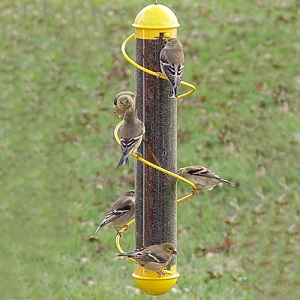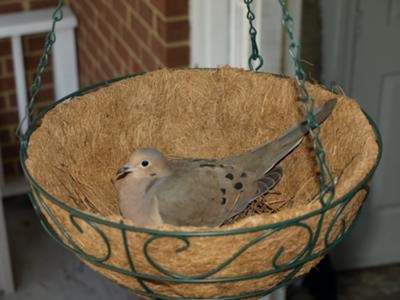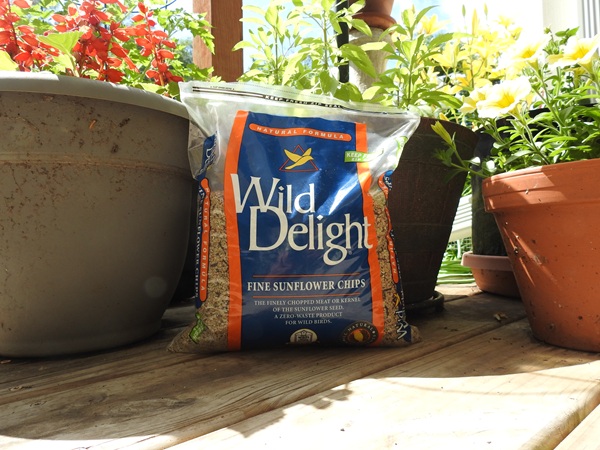American Goldfinch Field Guide: Nesting and Mating Habits
Last updated: April 24, 2025
At a Glance:
- Nesting: American Goldfinches begin nesting and egg laying in late summer. Preferring shrubs and trees near open fields.
- Diet: Their diet is primarily seeds, especially thistle and sunflower seeds.
- Lifespan: In the wild, goldfinches typically live 5 to 6 years.
Male Identification: Plumage Summer-Winter
Males are about 5 inches long from the tip of their bill to the end of their tail.
The winter plumage of the male is a yellowish brown, with light yellow on the face and chin, and the wings are black with white bars.
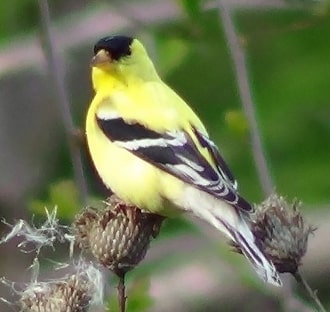
In summer, the male puts on his bright yellow breeding plumage that covers his body. He head has a black cap, and the tail and wings are black with white bands.
Female Appearance and Seasonal Changes
Female American goldfinches are not as brightly colored as the males. They are the same size as males and it's easy to tell the difference between the two.
Females are yellowish green with black wings and tails during summer breeding season, changing to a grayish brown with little yellow and dark brown wings with white wing bars after nesting season.
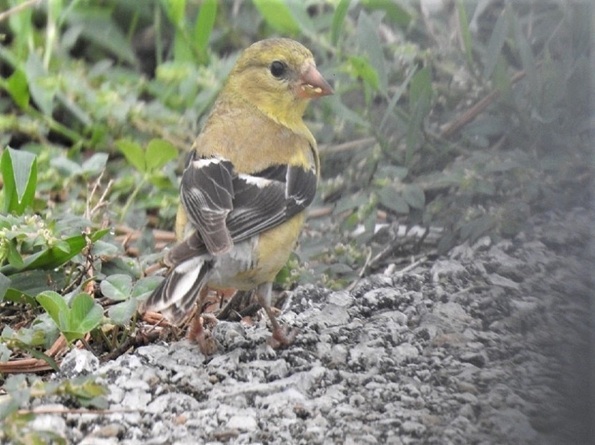
By keeping your feeder well stocked into spring, you'll see the vibrant yellow of the male and the more vivid hues of the female, as they enter the breeding stage.
The Goldfinches' song consists of a combination of short, clear notes and longer, trilling phrases. The males are known for their singing, especially during the nesting and breeding season.
Mating and Courtship: How They Choose Mates
Long before the nesting season, the courtship habits begin. Usually, several males try to attract the same female.
While there are short flutter flights high in the air between males, the most common behavior includes males chasing after females.
Several male birds may chase the female for twenty minutes or more over a large area, with the female likely to pick the dominant male for breeding.
Breeding Season: When They Lay Eggs
American Goldfinch Nesting Habits (Summary)
American Goldfinches are late-season nesters compared to most North American songbirds.
In much of their range, nesting and egg-laying begin in late June through July, with timing closely tied to the blooming and seed development of thistle and other composite plants.
In western regions, nesting may begin earlier, sometimes as early as May or June.
Nests are built almost exclusively by the female and are typically placed 4 to 20 feet above ground in shrubs or small trees located near open fields, wetlands, or gardens.
The nest is a compact, deep cup woven from fine plant fibers and spider silk, then densely lined with plant down, often from thistle seed heads.
The structure is woven so tightly that it can retain water.
The female lays 3 to 7 pale blue eggs and incubates them for 12 to 14 days while the male provides food.
Nestlings remain in the nest for about 11 to 15 days before fledging. One brood is typical, though a small percentage of females may raise a second brood in favorable conditions.
| American Goldfinch Nesting Timeline | |
|---|---|
| Eggs | 3 - 7 |
| Incubation | 12 - 14 days |
| Nestling Phase | 11 - 15 days |
| Broods | 1 - 2 |
Nesting Begins Earlier for Western Range
The breeding and nesting season begins earlier in the western part of the their range, egg laying activities can begin as early as May or June.
In the eastern part of their range, Goldfinches begin nesting and laying eggs in late July - August.
Why Do They Nest So Late?
It's believed that the blooming cycle of thistle plants plays a crucial role in dictating when goldfinch nest.
The fluffy seed heads from thistles serve as essential nesting materials. Then, as late summer approaches, these plants set seed which is eaten by the adults and regurgitated to the young back at the nest.
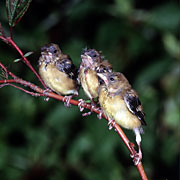
Nest Construction: A Female's Craft
The female builds a small nest just 2 inches wide inside and under 3 inches deep outside. The male guards her and their territory during this time.
Using strands of weeds, vines, and plant fibers for the foundation, and spider webbing to secure it to branches, she weaves a unique watertight cup.
The interior is lined with soft downy-like thistle blooms and caterpillar webbing, which protects the future eggs and chicks.
These nests sit 4 to 20 feet above ground in shrubs or small trees.
Laying Eggs and Incubation
After building the nest, both birds may temporarily leave before returning days later for egg-laying.
The female lays 3 to 7 light blue eggs over two weeks post-nest completion.
She incubates them for 12-14 days, while the male feeds her so she can remain on guard nearly full-time.
Nesting Habitat
The preferred habitat for nesting is an open area with a few scattered shrubs and trees.
They are likely to be found on farms and in backyard gardens. Most nests I find are in wetland areas and placed near the top of shrubs.
The nestlings will fledge about 11 to 15 days after hatching.
A second nest may be built by the female while the male continues to feed the first brood of fledglings.
Between 7 and 15 percent of female goldfinches will attempt a second clutch.
The young may be attended to by both adults for up to three weeks after leaving the nest.
Do They Reuse Nest?
Although rare, nests may be used for a second brood in the same breeding season. Other birds may use the nest if it is not being used.
They do not use the same nest from year to year. However, they may return to the same territory, providing they had a successful nesting season.
Feeding Habits and Diet
Feeding in the Wild
In the wild, goldfinches feed on Compositae plants also known as the Asteraceae family, which is one of the largest plant families.
Common Compositae Plants
- Sunflowers (Helianthus)
- Daisies (Leucanthemum vulgare)
- Goldenrod (Solidago)
- Asters (Aster)
- Dandelions (Taraxacum officinale)
- Thistles (Cirsium)
- Ragweed (Ambrosia)
- Yarrow (Achillea millefolium)
Winter Diet at the Feeder
It's important to feed all birds in winter as that's when they're most vulnerable.
It's a time that puts stress on the birds and allows for diseases to overtake them. Here are some options:
Types of Preferred Seeds
Black-oil Sunflowers Seed: Stay away from the stripped or Gray types as the birds find them less desirable.
Nyjer Seed (Also Called Thistle Seed) Not from the thistle plant, but imported and sterilized, which doesn't affect the nutritional value, but will keep it from sprouting.
If offering nyjer/thistle seed, you'll need a specially designed thistle feeder due to the small size of seed. The openings of sunflower seed feeder are too large.
I've found that the sunflower chips or hulled sunflower seed attracts goldfinches like a magnet and the cost is similar to nyjer seed. Use in the same thistle feeder to keep larger birds out.
A thistle feeder is the best way to offer the sunflower chips, otherwise it can get expensive as most birds prefer the easy meal.
Call: Sounds and Behavior
The Goldfinches' song consists of a combination of short, clear notes and longer, trilling phrases. The males are known for their singing, especially during the nesting and breeding season.
Do They Migrate South in Winter?
While it is considered a partial migrator, for most of the lower 48, they are permanent residents and do not go south in winter.
During the breeding season, they expand their territory as far as mid-Alberta. Those that breed in the northern regions will migrate southward during the winter.
In winter, goldfinches form flocks and exhibit less aggression toward one another. Males look more like the females during winter.
To assist all species of birds, I like to provide a Heated Birdbath in Winter.
How Long Do They Live: Lifespan
The lifespan of the American Goldfinch in the wild averages 3 - 6 years. Maximum Recorded - 11 years.
Video of this bird eating wild thistle
